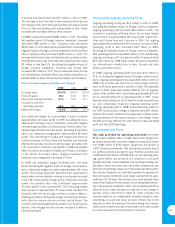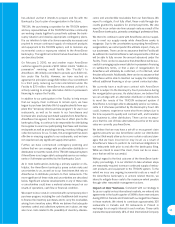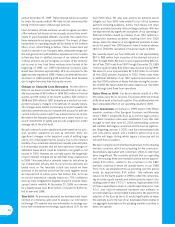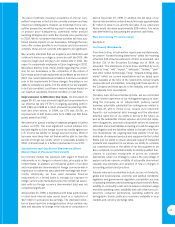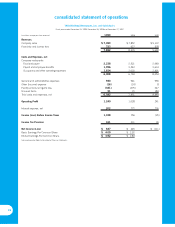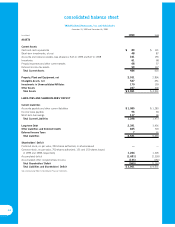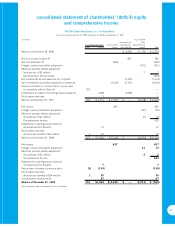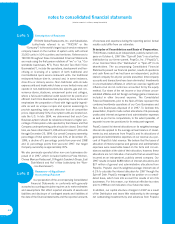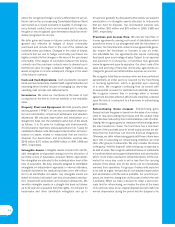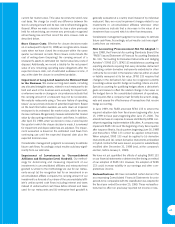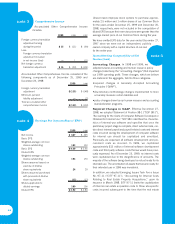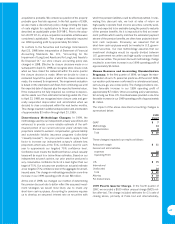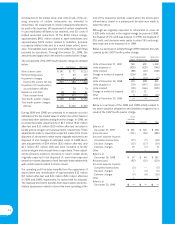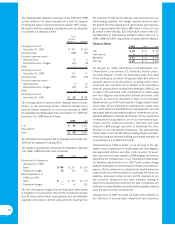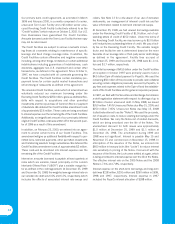Pizza Hut 1999 Annual Report Download - page 45
Download and view the complete annual report
Please find page 45 of the 1999 Pizza Hut annual report below. You can navigate through the pages in the report by either clicking on the pages listed below, or by using the keyword search tool below to find specific information within the annual report.
43
prior to the Spin-off. In connection with the Spin-off, we bor-
rowed $4.55 billion to fund a dividend and repayments to
PepsiCo, which exceeded the net aggregate balance owed at
the Spin-off Date by $1.1 billion.
Segment Disclosures. Effective December 28, 1997, we
adopted SFAS No. 131, “Disclosures About Segments of an
Enterprise and Related Information” (“SFAS 131”). Operating
segments, as defined by SFAS 131, are components of an
enterprise about which separate financial information is avail-
able that is evaluated regularly by the chief operating decision
maker in deciding how to allocate resources and in assessing
performance. This Statement allows aggregation of similar
operating segments into a single operating segment if the busi-
nesses are considered similar under the criteria of SFAS 131.
We identify our operating segments based on management
responsibility within the U.S. and International. For purposes
of applying SFAS 131, we consider our three U.S. Core
Business operating segments to be similar and therefore have
aggregated them into a single reportable operating segment.
Internal Development Costs and Abandoned Site
Costs. We capitalize direct internal payroll and payroll related
costs and direct external costs associated with the acquisition
of a site to be developed as a Company unit and the construc-
tion of a unit on that site. Only those site-specific costs incurred
subsequent to the time that the site acquisition is considered
probable are capitalized. We consider acquisition probable
upon final site approval. If we subsequently make a determi-
nation that a site for which internal development costs have
been capitalized will not be acquired or developed, the previ-
ously capitalized costs are expensed at this date and included
in general and administrative expenses.
Fiscal Year. Our fiscal year ends on the last Saturday in
December and, as a result, a fifty-third week is added every five
or six years. Fiscal years 1999, 1998 and 1997 comprised
52 weeks. Fiscal year 2000 will include a fifty-third week. Each
of the first three quarters of each fiscal year consists of 12 weeks
and the fourth quarter consists of 16 or 17 weeks. Our sub-
sidiaries operate on similar fiscal calendars with period end
dates suited to their businesses. Period end dates are within
one week of TRICON’s period end date with the exception of
our international businesses, which close one period or month
earlier to facilitate consolidated reporting.
Direct Marketing Costs. We report substantially all of our
direct marketing costs in occupancy and other operating
expenses in the Consolidated Statement of Operations, which
include costs of advertising and other marketing activities. We
charge direct marketing costs to expense ratably in relation to
revenues over the year in which incurred. Direct marketing
costs deferred at year-end consist of media and related ad pro-
duction costs. We expense these costs when the media or ad
is first used. Deferred advertising expense, classified as pre-
paid expenses in the Consolidated Balance Sheet, was
$3 million in 1999 and $4 million in 1998. Our advertising
expenses were $385 million, $435 million and $517 million in
1999, 1998 and 1997, respectively. The decline in our adver-
tising expense is a direct result of substantially fewer Company
stores as a result of our major refranchising program.
Research and Development Expenses. Research and
development expenses, which we expense as incurred, were
$24 million in 1999 and $21 million in both 1998 and 1997.
Stock-Based Employee Compensation. We measure
stock-based employee compensation cost for financial state-
ment purposes in accordance with Accounting Principles
Board Opinion No. 25, “Accounting for Stock Issued to
Employees,” and its related interpretations and include pro
forma information in Note 15 as required by Statement of
Financial Accounting Standards No. 123, “Accounting for
Stock-Based Compensation” (“SFAS 123”). Accordingly, we
measure compensation cost for the stock option grants to our
employees as the excess of the average market price of our
Common Stock at the grant date over the amount the employee
must pay for the stock. Our policy is to generally grant stock
options at the average market price of the underlying Common
Stock at the date of grant.
Earnings (Loss) Per Common Share. In the accom-
panying Consolidated Statement of Operations, we have
omitted loss per share information for 1997 as our capital struc-
ture as an independent, publicly owned company did not exist
for the entire year.
Derivative Instruments. From time to time, we utilize inter-
est rate swaps, collars and forward rate agreements to hedge
our exposure to fluctuations in variable interest rates.
We recognize the interest differential to be paid or received on
interest rate swap and forward rate agreements as an adjust-
ment to interest expense as the differential occurs. We
recognize the interest differential to be paid or received on an
interest rate collar as an adjustment to interest expense only if
the interest rate falls below or exceeds the contractual collared
range. We reflect the recognized interest differential not yet set-
tled in cash in the accompanying Consolidated Balance Sheet
as a current receivable or payable. If we were to terminate an
interest rate swap, collar or forward rate position, any gain or
loss realized upon termination would be deferred and amor-
tized to interest expense over the remaining term of the
underlying debt instrument it was intended to modify or would
be recognized immediately if the underlying debt instrument
was settled prior to maturity.
We recognize foreign exchange gains and losses on forward
contracts that are designated and effective as hedges of for-
eign currency receivables each period as the differential
occurs. This is fully offset by the corresponding gain or loss rec-
ognized in income on the currency translation of the receivable,
as both amounts are based upon the same exchange rates. We


